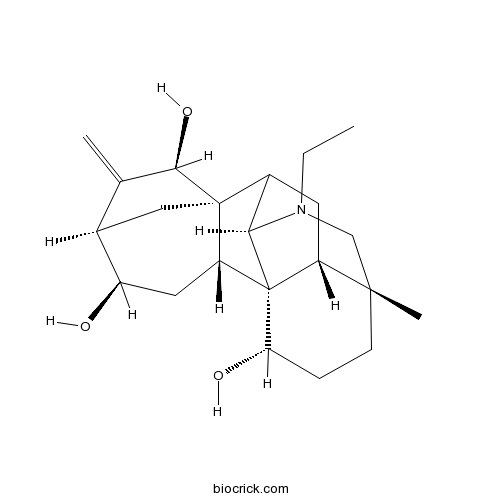12-EpinapellineCAS# 110064-71-6 |

- Napelline
Catalog No.:BCX1285
CAS No.:5008-52-6
Quality Control & MSDS
3D structure
Package In Stock
Number of papers citing our products

| Cas No. | 110064-71-6 | SDF | Download SDF |
| PubChem ID | 102004858 | Appearance | Powder |
| Formula | C22H33NO3 | M.Wt | 359.5 |
| Type of Compound | Alkaloids | Storage | Desiccate at -20°C |
| Solubility | Soluble in Chloroform,Dichloromethane,Ethyl Acetate,DMSO,Acetone,etc. | ||
| SMILES | CCN1CC2(CCC(C34C2CC(C31)C56C4CC(C(C5)C(=C)C6O)O)O)C | ||
| Standard InChIKey | AZAZKLKDEOMJBJ-WMLJXHKFSA-N | ||
| General tips | For obtaining a higher solubility , please warm the tube at 37 ℃ and shake it in the ultrasonic bath for a while.Stock solution can be stored below -20℃ for several months. We recommend that you prepare and use the solution on the same day. However, if the test schedule requires, the stock solutions can be prepared in advance, and the stock solution must be sealed and stored below -20℃. In general, the stock solution can be kept for several months. Before use, we recommend that you leave the vial at room temperature for at least an hour before opening it. |
||
| About Packaging | 1. The packaging of the product may be reversed during transportation, cause the high purity compounds to adhere to the neck or cap of the vial.Take the vail out of its packaging and shake gently until the compounds fall to the bottom of the vial. 2. For liquid products, please centrifuge at 500xg to gather the liquid to the bottom of the vial. 3. Try to avoid loss or contamination during the experiment. |
||
| Shipping Condition | Packaging according to customer requirements(5mg, 10mg, 20mg and more). Ship via FedEx, DHL, UPS, EMS or other couriers with RT, or blue ice upon request. | ||
| Description | 12-Epinapelline is a natural product from Aconitum kusnezoffii Reichb. |
| Structure Identification | Chemistry of Natural Compounds, 2005,41(5):609.Crystal and Molecular Structure of 12-Epinapelline[Reference: WebLink]
|

12-Epinapelline Dilution Calculator

12-Epinapelline Molarity Calculator
| 1 mg | 5 mg | 10 mg | 20 mg | 25 mg | |
| 1 mM | 2.7816 mL | 13.9082 mL | 27.8164 mL | 55.6328 mL | 69.541 mL |
| 5 mM | 0.5563 mL | 2.7816 mL | 5.5633 mL | 11.1266 mL | 13.9082 mL |
| 10 mM | 0.2782 mL | 1.3908 mL | 2.7816 mL | 5.5633 mL | 6.9541 mL |
| 50 mM | 0.0556 mL | 0.2782 mL | 0.5563 mL | 1.1127 mL | 1.3908 mL |
| 100 mM | 0.0278 mL | 0.1391 mL | 0.2782 mL | 0.5563 mL | 0.6954 mL |
| * Note: If you are in the process of experiment, it's necessary to make the dilution ratios of the samples. The dilution data above is only for reference. Normally, it's can get a better solubility within lower of Concentrations. | |||||

Calcutta University

University of Minnesota

University of Maryland School of Medicine

University of Illinois at Chicago

The Ohio State University

University of Zurich

Harvard University

Colorado State University

Auburn University

Yale University

Worcester Polytechnic Institute

Washington State University

Stanford University

University of Leipzig

Universidade da Beira Interior

The Institute of Cancer Research

Heidelberg University

University of Amsterdam

University of Auckland

TsingHua University

The University of Michigan

Miami University

DRURY University

Jilin University

Fudan University

Wuhan University

Sun Yat-sen University

Universite de Paris

Deemed University

Auckland University

The University of Tokyo

Korea University
- 7-Hydroxy-3-(4-hydroxybenzylidene)chroman-4-one
Catalog No.:BCN1624
CAS No.:110064-50-1
- Strophantin K (mixture)
Catalog No.:BCC8256
CAS No.:11005-63-3
- Calpain Inhibitor I, ALLN
Catalog No.:BCC1233
CAS No.:110044-82-1
- Tussilagonone
Catalog No.:BCC8365
CAS No.:110042-38-1
- Taurohyodeoxycholic Acid Sodium Salt
Catalog No.:BCC8363
CAS No.:110026-03-4
- 8-O-Ethylyunaconitine
Catalog No.:BCN6260
CAS No.:110011-77-3
- Sorbic acid
Catalog No.:BCN2218
CAS No.:110-44-1
- Fumaric acid
Catalog No.:BCN5989
CAS No.:110-17-8
- Maleic acid
Catalog No.:BCN8426
CAS No.:110-16-7
- Succinic acid
Catalog No.:BCN5890
CAS No.:110-15-6
- ITD 1
Catalog No.:BCC6409
CAS No.:1099644-42-4
- Kifunensine
Catalog No.:BCC7601
CAS No.:109944-15-2
- Plerixafor (AMD3100)
Catalog No.:BCC1158
CAS No.:110078-46-1
- des-His1-[Glu9]-Glucagon (1-29) amide
Catalog No.:BCC5885
CAS No.:110084-95-2
- Ascomycin
Catalog No.:BCN8286
CAS No.:11011-38-4
- Indoximod (NLG-8189)
Catalog No.:BCC5584
CAS No.:110117-83-4
- Methyl hesperidin
Catalog No.:BCN6341
CAS No.:11013-97-1
- 4-Galloylquinic acid
Catalog No.:BCN3733
CAS No.:110170-37-1
- Ouabain Octahydrate
Catalog No.:BCC5211
CAS No.:11018-89-6
- JZL184
Catalog No.:BCC4790
CAS No.:1101854-58-3
- 1,5,8-Trihydroxy-3-methoxy-2-prenylxanthone
Catalog No.:BCN1623
CAS No.:110187-11-6
- Malonylginsenoside Rb(1)
Catalog No.:BCC9230
CAS No.:88140-34-5
- Cochliophilin A
Catalog No.:BCC8154
CAS No.:110204-45-0
- Ginsenoside Rb2
Catalog No.:BCN1064
CAS No.:11021-13-9
Analgesic activity of diterpene alkaloids from Aconitum baikalensis.[Pubmed:25110090]
Bull Exp Biol Med. 2014 Aug;157(4):488-91.
We compared analgesic activities of individual alkaloids extracted from Baikal aconite (Aconitum baikalensis): napelline, hypaconitine, songorine, mesaconitine, 12-Epinapelline N-oxide. The detected analgesic activity was comparable to that of sodium metamizole. The mechanisms of analgesia were different in diterpene alkaloids of different structure. The antinociceptive effect of atisine alkaloids (12-Epinapelline N-oxide, songorine) was naloxonedependent and realized via opioid receptor modulation.
Anti-inflammatory activity of diterpene alkaloids from Aconitum baikalense.[Pubmed:24770754]
Bull Exp Biol Med. 2014 Mar;156(5):665-8.
We compared anti-inflammatory activity of individual diterpene alkaloids isolated from Aconitum baikalense (napelline, songorine, hypaconitine, mesaconitine, 12-Epinapelline N-oxide) under conditions of acute inflammation of different genesis. The tested substances showed high antiexudative activity comparable with that of sodium diclofenac. Unlike nonsteroidal anti-inflammatory drugs, diterpene alkaloids exerted no ulcerogenic effect.
Regeneratory characteristics of complex extract and isolated diterpene alkaloids of Aconitum baikalense.[Pubmed:22803106]
Bull Exp Biol Med. 2012 Feb;152(4):439-43.
The effects of complex extract from Aconitum baikalense on reparative regeneration of a plane dorsal skin wound were studied. Treatment with Aconitum baikalense tincture stimulated reparation and skin regeneration. The effects of the Aconitum baikalense alkaloids on functional activity of fibroblast precursors were studied in vitro by cultural methods. Mesaconitine, hypaconitine, songorine, napelline, and 12-Epinapelline N-oxide significantly stimulated the growth of colonies from fibroblast precursors. This indicated direct stimulation of fibroblasts by aconite alkaloids, which could be a mechanism of reparative activity of the complex extract.


